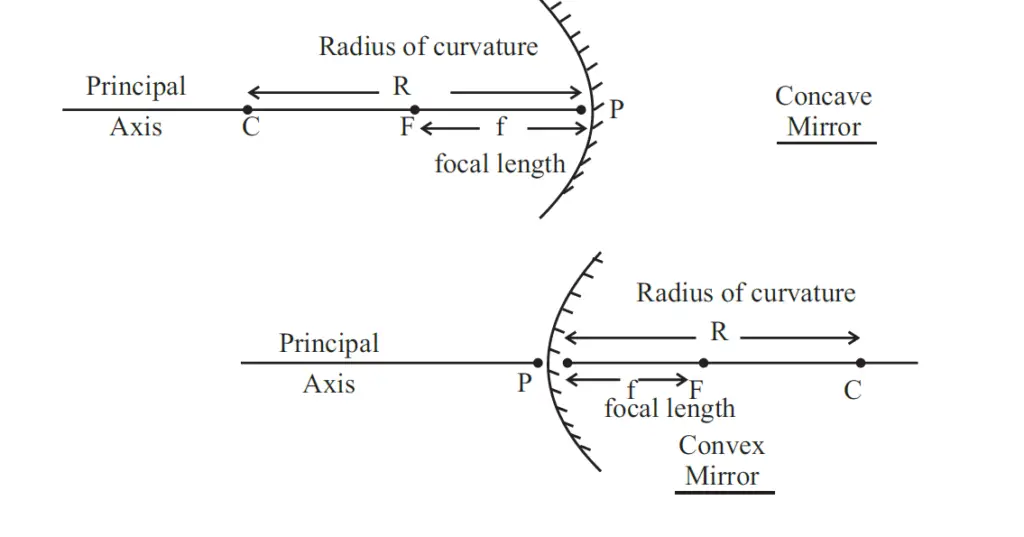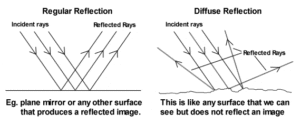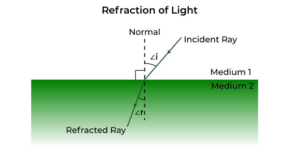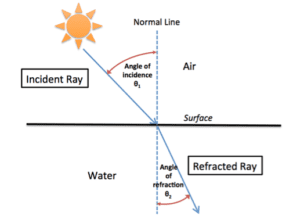Spherical mirrors are mirrors that have a curved reflecting surface, which can either be convex (outwardly curved) or concave (inwardly curved). The reflecting surface they have is shaped like a portion of a sphere.
They are commonly used in a variety of optical devices, such as telescopes, microscopes, reflective headlights, etc. There are two main types of spherical mirrors: concave mirrors and convex mirrors.
In this article, we will discuss spherical mirrors, their definition, types, uses, and terminologies. So let’s get started…
Historical background of spherical mirrors
Spherical mirrors have played a significant role in human civilization, both in science and daily life. Here is a brief historical background on spherical mirrors:

Ancient Greece (circa 4th century BCE)
- The concept of reflection and optics was studied by ancient Greek philosophers such as Euclid and Hero of Alexandria.
- Euclid’s “Optica” discussed the principles of reflection, and Hero of Alexandria described the use of curved mirrors to focus sunlight for practical purposes.
Islamic Golden Age (8th to 14th centuries)
- Muslim scholars like Ibn al-Haytham (Alhazen) made significant contributions to optics.
- Alhazen’s “Book of Optics” explained the behavior of light, reflection, and refraction. He also discussed the properties of spherical mirrors.
Renaissance (14th to 17th centuries)
- Advances in glassmaking allowed for the production of better-quality mirrors.
- The use of convex mirrors became popular for practical purposes, such as in the production of magnifying glasses and improving the field of view in artistic mirrors.
17th Century
- Johannes Kepler formulated the laws of reflection in his work, “Dioptrice” (1611).
- Sir Isaac Newton designed the first practical reflecting telescope using a curved mirror in 1668.
18th Century
- Cassegrain telescopes, which utilize a combination of convex and concave mirrors, were developed by the French astronomer Guillaume Cassegrain.
19th Century
- The development of curved mirrors continued in various scientific fields.
- Spherical mirrors were employed in lighthouses to focus and amplify light for maritime navigation.
20th Century
- Advances in technology led to the development of curved mirrors in various optical instruments, including cameras and projectors.
- Spherical mirrors found applications in the automotive industry for rear-view mirrors.
21st Century
- Spherical mirrors continue to be integral in optical systems, including telescopes, microscopes, and various imaging devices.
- Advancements in materials and manufacturing processes have improved the quality and precision of spherical mirrors.
Types of Spherical Mirrors
Spherical mirrors are curved mirrors whose reflecting surface is shaped like a portion of a sphere. There are two main types of spherical mirrors:
- Concave mirrors
- Convex mirrors
Concave Mirrors

- A concave mirror is curved inward, resembling the inner surface of a sphere. These mirrors have a surface that curves inward. The inner side of the mirror is reflective, while the outer side is silver-polished.
- It can focus light rays that are parallel to its axis on a single point known as the focal point.
- If the object is located beyond the focal point, a real and inverted image is formed. If the object is between the focal point and the mirror, the image is virtual, erect, and magnified.
- These mirrors are also called converging mirrors because the light rays that strike a concave mirror parallel to its principal axis converge to a focal point after reflection.
Convex Mirrors

- A convex mirror is curved outward, resembling the outer surface of a sphere. These mirrors have a surface that curves outward. The outer side of the mirror is reflective, while the inner side is silver-polished.
- It diverges parallel incident light rays, making them appear to diverge from a virtual focal point behind the mirror.
- These mirrors are also called diverging mirrors because, when parallel rays of light strike a convex mirror, they diverge, appearing to originate from a focal point behind the mirror.
- Convex mirrors always produce virtual, erect, and diminished images, regardless of the object’s position.
Terminologies related to spherical mirrors
There are some basic terminologies related to spherical mirrors that need to be known while studying spherical mirrors. Here are definitions of some important terms related to spherical mirrors.

- Pole or vertex: It is the midpoint of a spherical mirror.
- Principal Axis: The imaginary line passing through the center of curvature (C) and the midpoint of the mirror (vertex). It is the principal axis along which distances are measured.
- Focal point or principle focus (F): the point on the principal axis where parallel rays either converge (for concave mirrors) or appear to diverge (for convex mirrors) after reflection. It is half the distance between the center of curvature and the mirror’s vertex.
- Focal Length (f): The distance between the focal point and the mirror’s vertex. It is also half the radius of curvature.
- Focal plane: It is a vertical plane that passes through the principal focus and is perpendicular to the principal axis.
- Radius of Curvature (R): The distance from the center of curvature to the vertex of the mirror. For a spherical mirror, it is twice the focal length.
- Center of curvature (C): The point in the center of the mirror passes through the curve of the mirror and has the same tangent and curvature at that point.
- Aperture: The effective diameter of the mirror, which affects the amount of light gathered or reflected.
- Angular aperture: It is the maximum angle at which light rays can enter or exit the mirror and still be effectively reflected or focused. It determines the range of angles over which the mirror can gather or emit light effectively.
Read More:
- Behaviour of light at the interface of two media
- Optics: definition, types, and applications, class 12
- Simple microscope Class 12, Definition, Magnification, working, Parts And Uses
- Reflection of light class 12: definition and types
Structure of spherical mirrors
The structure of a spherical mirror refers to its physical characteristics and components. A spherical mirror consists of a curved surface that can be either convex or concave. Let’s explore the structure of both types:

Concave Spherical Mirror
- Reflective Surface: The inner side of a concave mirror is coated with a reflective material, typically aluminum or silver. This reflective surface is responsible for reflecting light rays.
- Curvature: The surface of a concave mirror curves inward, forming a hollow shape. It is thicker at the center and gradually thins towards the edges.
- Principal Axis: The principal axis of a concave mirror is an imaginary line passing through the center of curvature (C) and the vertex (V) of the mirror. It is the line along which light rays are reflected and measured.
- Center of Curvature: The center of curvature (C) is the geometric center of the sphere from which the mirror is derived. It lies on the principal axis, and the radius of curvature is the distance between the center of curvature and the vertex of the mirror.
- Pole or Vertex: The vertex (V) of a concave mirror is the geometric center of its reflective surface. It lies on the principal axis and is the point where the principal axis intersects the mirror.
Convex Spherical Mirror
- Reflective Surface: The outer side of a convex mirror is coated with a reflective material. Unlike concave mirrors, the reflective coating is on the outer side, facing away from the curvature.
- Curvature: The surface of a convex mirror curves outward, forming a bulging shape. It is thinner at the center and gradually thickens towards the edges.
- Principal Axis: The principal axis of a convex mirror is an imaginary line passing through the center of curvature (C) and the vertex (V) of the mirror. Light rays are reflected away from the principal axis.
- Center of Curvature: The center of curvature (C) of a convex mirror is the geometric center of the sphere from which the mirror is derived. It lies on the principal axis, and the radius of curvature is the distance between the center of curvature and the vertex of the mirror.
- Pole or Vertex: The vertex (V) of a convex mirror is the geometric center of its reflective surface. It lies on the principal axis and is the point where the principal axis intersects the mirror.
Uses of spherical mirrors
Concave and convex mirrors have distinct optical properties, and they find various practical applications based on these properties.
Uses of Concave Mirrors

- Reflecting Telescopes: Concave mirrors are commonly used in reflecting telescopes, such as the Newtonian telescope designed by Sir Isaac Newton. The concave mirror collects and focuses light to produce an image, which can then be magnified by eyepieces.
- Makeup Mirrors: Concave mirrors are often used in makeup mirrors to provide magnification. The converging nature of the mirror allows for a closer and more detailed view of the face.
- Headlights of Vehicles: Some vehicle headlights use concave mirrors to spread and focus the light efficiently, enhancing visibility on the road.
- Solar Cookers: Concave mirrors can be used to concentrate sunlight onto a focal point, creating high temperatures. This property is exploited in solar cookers, where concentrated sunlight is used for cooking.
- Ophthalmic Lenses: Concave mirrors, particularly in eyeglasses and contact lenses, are used to correct nearsightedness (myopia). These mirrors diverge light before it enters the eye, compensating for the eye’s focusing issue.
Uses of Convex Mirrors

- Wide-angle Rear-view Mirrors: Convex mirrors are commonly used as side-view or rear-view mirrors in vehicles. They provide a wider field of view, helping drivers to see more of the surrounding traffic and reduce blind spots.
- Security Mirrors: Convex mirrors are used in security and surveillance systems to provide a broad view of areas, such as in stores or parking lots, helping to prevent theft and enhance security.
- Decorative Mirrors: Convex mirrors are sometimes used for decorative purposes due to their unique reflective properties. They can create interesting and distorted reflections, adding aesthetic value.
- Dentist Mirrors: Convex mirrors are used in dentistry to provide a broader view of the patient’s mouth, making it easier for dentists to see and work on teeth from various angles.
- Traffic and Safety Mirrors: Convex mirrors are installed at intersections, driveways, and parking lots to improve visibility and safety by allowing drivers to see around corners and observe oncoming traffic.
Frequently Asked Questions (FAQs)
What are spherical mirrors?
Spherical mirrors are mirrors that have a curved reflecting surface, which can either be convex (outwardly curved) or concave (inwardly curved).
What are the two types of spherical mirrors?
There are two main types of spherical mirrors: concave mirrors
and convex mirrors.
Define the focal length of a spherical mirror.
It is the distance between the focal point and the mirror’s vertex. It is also half the radius of curvature.
What is the difference between a concave and a convex spherical mirror?
A concave mirror curves inward and can converge light rays, while a convex mirror curves outward and diverges light rays.
How does a concave mirror reflect light?
A concave mirror reflects light by causing parallel incident rays to converge at a focal point, creating a real or virtual image.
What are the uses of convex mirrors?
Convex mirrors are commonly used in rear-view mirrors of vehicles and security mirrors to provide a wider field of view.








